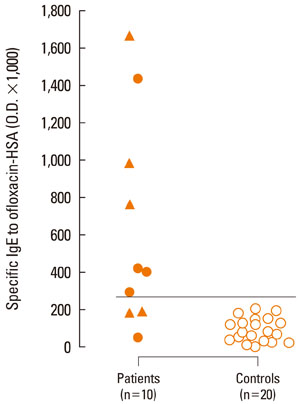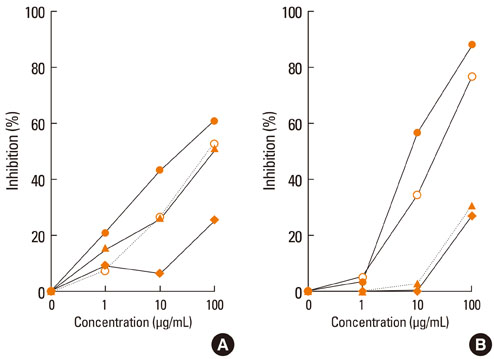Allergy Asthma Immunol Res.
2012 Nov;4(6):367-369. 10.4168/aair.2012.4.6.367.
Immunologic Evaluation of Ofloxacin Hypersensitivity
- Affiliations
-
- 1Department of Allergy & Clinical Immunology, Ajou University School of Medicine, Suwon, Korea. hspark@ajou.ac.kr
- 2Division of Pulmonology and Critical Care Medicine, Department of Internal Medicine, Samsung Changwon Hospital, Sungkyunkwan University School of Medicine, Changwon, Korea.
- 3Department of Internal Medicine, Yeungnam University College of Medicine, Daegu, Korea.
- KMID: 2167029
- DOI: http://doi.org/10.4168/aair.2012.4.6.367
Abstract
- Quinolone hypersensitivity, most of which is immediate type, is rare but has increased in recent years. The pathogenic mechanisms underlying immediate reactions are not defined clearly. This study was aimed to observe the clinical characteristics of immediate hypersensitivity to ofloxacin and to investigate the pathogenic mechanism with detection of serum specific IgE to ofloxacin using an enzyme-linked immunoasorbent assay (ELISA). We recruited 5 patients with immediate hypersensitivity reactions to ofloxacin (group I), and as control groups, 5 subjects with ciprofloxacin hypersensitivity (group II) and 20 healthy subjects with no history of drug allergy. Serum specific-IgE to ofloxacin-human serum albumin (HSA) conjugate was detectable in four group I subjects (80%) and three group II subjects (60%). The ELISA inhibition test showed significant inhibition with both ofloxacin-HSA conjugate and free ofloxacin in a dose-dependent manner. As to ciprofloxacin, significant inhibition was noted upon addition of free ciprofloxacin in one subject, while minimal inhibition was noted in the other. We confirmed that an IgE-mediated response is a major pathogenic mechanism of ofloxacin hypersensitivity. Cross reactivity between ofloxacin and ciprofloxacin was noted with individual difference.
Keyword
MeSH Terms
Figure
Cited by 1 articles
-
An Ofloxacin-Induced Anaphylaxis through an IgG4-Mediated but Not IgE-Mediated Basophil Activation Mechanism
Ji Hye Kim, Dae-Hong Seo, Ga-Young Ban, Eun-Mi Yang, Yoo Seob Shin, Young-Min Ye, Hae-Sim Park
Korean J Crit Care Med. 2017;32(3):302-305. doi: 10.4266/kjccm.2017.00108.
Reference
-
1. Bertino J Jr, Fish D. The safety profile of the fluoroquinolones. Clin Ther. 2000. 22:798–817. discussion 797.2. Suh YJ, Lee YM, Choi JH, Suh CH, Nahm DH, Park HS. Heterogeneity of IgE response to cefteram pivoxil was noted in 2 patients with cefteram-induced occupational asthma. J Allergy Clin Immunol. 2003. 112:209–210.3. Kim JE, Kim SH, Jin HJ, Hwang EK, Kim JH, Ye YM, Park HS. IgE Sensitization to Cephalosporins in Health Care Workers. Allergy Asthma Immunol Res. 2012. 4:85–91.4. Demoleas SE, Davies GF. Quinolones. Oral antibiotics of the future. J Am Podiatr Med Assoc. 1988. 78:522–525.5. Dembry LM, Farrington JM, Andriole VT. Fluoroquinolone antibiotics: adverse effects and safety profiles. Infect Dis Clin Pract (Baltim Md). 1999. 8:421–428.6. Aranda A, Mayorga C, Ariza A, Doña I, Rosado A, Blanca-Lopez N, Andreu I, Torres MJ. In vitro evaluation of IgE-mediated hypersensitivity reactions to quinolones. Allergy. 2011. 66:247–254.7. Manfredi M, Severino M, Testi S, Macchia D, Ermini G, Pichler WJ, Campi P. Detection of specific IgE to quinolones. J Allergy Clin Immunol. 2004. 113:155–160.8. Reaño M, Vives R, Rodríguez J, Daroca P, Canto G, Fernández J. Ciprofloxacin-induced vasculitis. Allergy. 1997. 52:599–600.9. Dávila I, Diez ML, Quirce S, Fraj J, De La Hoz B, Lazaro M. Cross-reactivity between quinolones. Report of three cases. Allergy. 1993. 48:388–390.10. Seitz CS, Bröcker EB, Trautmann A. Diagnostic testing in suspected fluoroquinolone hypersensitivity. Clin Exp Allergy. 2009. 39:1738–1745.11. Schmid DA, Campi P, Pichler WJ. Hypersensitivity reactions to quinolones. Curr Pharm Des. 2006. 12:3313–3326.12. González I, Lobera T, Blasco A, del Pozo MD. Immediate hypersensitivity to quinolones: moxifloxacin cross-reactivity. J Investig Allergol Clin Immunol. 2005. 15:146–149.13. Lobera T, Audícana MT, Alarcón E, Longo N, Navarro B, Muñoz D. Allergy to quinolones: low cross-reactivity to levofloxacin. J Investig Allergol Clin Immunol. 2010. 20:607–611.
- Full Text Links
- Actions
-
Cited
- CITED
-
- Close
- Share
- Similar articles
-
- Anaphylactoid reaction to ofloxacin with cross-reactivity to other fluoroquinolones
- High Dose Ofloxacin-induced Bimodal Hallucinations in a 4 Years Old Child
- Activity of Moxifloxacin Against Ofloxacin-Resistant Mycobacterium Tuberculosis: A Study of Cross-Resistance Between Ofloxacin and Moxifloxacin
- In vitro activities of meropenem, imipenem and ofloxacin against aerobic gram-negative bacilli and gram-positive cocci
- Treatment of Uncomplicated Male Gonococcal Urethritis with Ofloxacin



